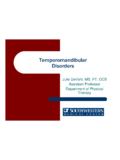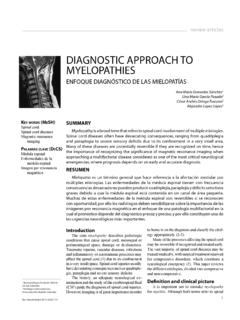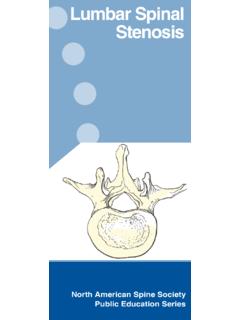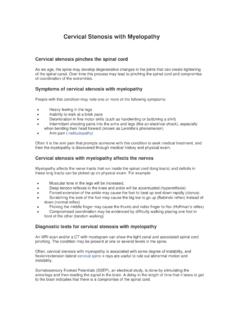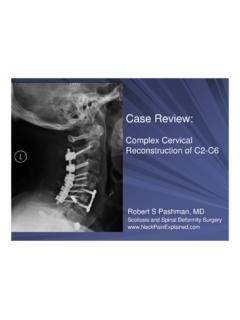Transcription of lumbar spine home study - Home Page - Continuing ED
1 1 Anatomy, Biomechanics and Pathology of the lumbar SpineBeth K. Deschenes, PT, MS, OCSL umbar Vertebrae 4 Functional Components Vertebrae body Pedicle Lamina (post element) Facet joint (post element)Vertebral Body Designed for weight bearing and absorption of longitudinal directed fforces Boxed shape with flat top and bottom surfaces (external) Vertical/Horizontal trabeculae (internal) Vertical load transverse tension Dynamic loadingPedicle Bony struts Only connection btt ibetween posterior elements and vertebral body Transfer forces from post elements to vertebral bodyLamina Project from each pedicle towards midlinemidline Completes formation of neural arch Transfer forces from post elementsPars Interarticularis Junction between lamina/pedicleAf hi h b di Area of high bending forces/susceptibility Fatigue fracture/spondylolysis2 Spondylolysis Spondylolysis-defect or break in the area between thebetween the superior/inferior articular process- fatigue fracture Facet Joint Bony locking mechanism Ati l ti b t Articulation between SAP/IAP Synovial joint with hyaline cartilageFacet Joint (orientation)
2 Typically oriented in the sagittal/frontal plane Sagittal orientation-gcontrol rotation Frontal orientation-control anterior shear Protects the disc Variability in joint orientationFacet Joint (meniscoids) Synovial fold projecting into joint (2-5mm) Protect exposed articular cartilage during pggflexion Potential for entrapment during return from flexion (space occupying lesion) which may account for locked back or acute torticollis in the cervical spineSummary- lumbar Vertebrae Vertebral body designed for absorption of longitudinal directed forces Bony struts (laminal pedicle) allowing for transfer of forces Facet joint ( bony locking mechanism ) that protects the disc by controlling anterior translation and of the lumbar Spine3 Ligaments of the Vertebral Bodies Annulus fibrosus Anterior longitudinal ligamentgg Posterior longitudinal ligamentAnterior Longitudinal Ligament Covers the anterior aspect of the lumbar spine Continuous into the thoracic and cervical spine Primary attachment-anterior vertebral bodies Loosely attached to IVD Functions during extension motion to resist anterior bowing of the lumbar spinePosterior Longitudinal Ligament Covers the posterior aspect of the lumbar spinep Narrowed centrally Expands laterally over the IVD (saw-tooth appearance) Functions to resist separation of the posterior vertebral body (flexion)
3 Ligaments of the Posterior Elements Ligamentum flavum Interspinous ligamentpg Supraspinous ligament Iliolumbar ligamentLigamentum Flavum Short/thick-joins lamina of consecutive vertebrae Paired at each level Paired at each level Medial aspect forms anterior capsule of facet joint 80% elastin/20% collagenLigamentum Flavum Resists flexion Elastic nature prevents buckling inward during segmental approximationsegmental approximation Evidence that pathology in this ligament plays a role in the etiology of spinal stenosis Degeneration of elastic fibers Proliferation of collagen fibers Calcification and ossification of ligament4 Interspinous Ligament Connects adjacent spinous processes Fibers oriented obliquely- Fibers oriented obliquelyanterior to posterior Offers little resistance to flexionSupraspinous Ligament Lies posterior to the spinous process Consist of 3 layers composed of: Tendinous fibers from longissimus thoracics Dorsal layer of the TLF Well developed in the upper lumbar spine (L3) Regularly absent in lower lumbar spine (L4/L5) Affords resistance to separationIliolumbar Ligament Present bilaterally Runs from the TP of L5to the ant/med edge of thethe ant/med edge of the post ilium An L4band has been identified Some question as to its presence in children/adolescence Function: stabilize L5on the sacrumAnatomy of the lumbar LordosisFormation of Lordosis Upper surface of sacrum inclined forward lumbar spine must incline backback Wedge shape of L5-S1disc Wedge shape of L5vertebral body Slight inclination of vertebrae aboveAdvantage of the Lordosis Axial compression Transmitted thru ti IVDposterior IVD Anterior aspect of vertebrae separate Tension in ALL Energy diverted into stretching ALL5 Liability of the Lordosis Tendency for L5and L4anterior migration Liability controlled by.
4 Yy Bony locking mechanism (frontal orientation) Annulus fibrosus (anterior oriented lamella) Iliolumbar ligament Anterior longitudinal ligamentWhat is Considered a Normal Lordosis? Difficult to determine Variation between individuals Appears to be a correlation between a loss of lordosis and the development of back pain and degenerative changes in the spine ( flat back syndrome )SummaryLumbar Lordosis Shape formed by inclination of sacrum and wedge shape of L5-S1disc and L5vertebrae Anterior migration of L5and L4controlled by facet joint/ligaments No universally accepted norm Loss of may predispose individual to increase compressive load on the IVDN erves of the lumbar SpineSpinal Cord spinal Cord terminates at L1-L2Lb dS l lumbar and Sacral ventral/dorsal roots course inferior (cauda equina) spinal canal Surrounds the cauda equina Anterior border Anterior border Vertebral body (posterior) IVD PLL Posterior border Lamina Ligamentum flavum Lateral border Pedicles6 spinal canal Upper lumbar level-ovalLlbll Lower lumbar level-triangular or trefoilSpinal canal Dynamics Cross-sectional area with flexion with extension Rule of Progressive Narrowing -Penning (1992): with compression(1992).
5 The more the canal is structurally narrowed by a stenosis the more it will be narrowed by extension Cross-sectional area during extension Normal spine - 9% Stenotic spine - 67% spinal Nerves Nerve roots leave dural sac but take an extension of the dural lsleeve Merge to form spinal nerve spinal nerve is numbered according to vertebrae beneath which it liesIntervertebral Foramen Anterior Vertebral body/IVDPti Posterior Facet joint Ligamentum flavum Superior/Inferior PedicleIntervertebral Foramen spinal nerve normally occupies superior aspect Variability in cross Variability in cross sectional area Generally from L1-2to L4-5 L5-S1-smallest L5spinal nerve most susceptible to foraminal stenosisSummary spinal cord terminates at L1-L2 Cauda equina extends inferiorly and is surrounded by the spinal canalp spinal nerve numbered according to the vertebrae beneath which it lies spinal nerve occupies IVF L5 spinal nerve most susceptible to foraminal stenosis Extension decreases the size of the spinal canal and IVF Flexion increases the size of the spinal canal and IVF7 Anatomy of Intervertebral DiscIntervertebral Disc Annulus fibrosus Nucleus pulposuspp Vertebral endplateAnnulus Fibrosus Sheets of collagen fibers (lamellae) Oriented 65 -70 to Oriented 65-70to the vertical Direction of each lamellae alternates Anterior/lateral portions-thicker Posterior portion-thinnerNucleus Pulposus 70%-90% water Few collagen cells llfibicollagen fibers in a semi fluid ground substance Avascular structureVertebral Endplate Layer of cartilage on inferior/superior surfaces Covers nucleus pulposus and part of annulus Fibers of annulus fibrosus swing centrally Nucleus pulposus completely encapsulated Critical area for nutrient supplyFunction in Weight Bearing.
6 The hydrostatic mechanism Compression increase in pressure in nucleus pulposuspp Pressure exerted radially on annulus Tension in annulus (annular bracing) Tension exerted back on nucleus Nuclear pressure exerted on the endplate8 Function (control segmental movement) Sliding, rotary and distractive motions-controlled by annular tensionFunction (control segmental movement) Rocking motions (flexion/extension) controlled by nuclear/annular deformationnuclear/annular deformation Forward bend Anterior annulus compressed Posterior annulus tension Nucleus migrates posterior Extension Anterior annulus tension Posterior annulus compressed Nucleus migrates anteriorSummary Intervertebral Disc A design of 3 primary structures: Nucleus, Annulus, and Endplate Nucleus/Endplate designed to transmit pressure Annulus acts like a ligament to control segmental movementBiomechanics the lumbar SpineLumbar spine Motion segment: two adjoining vertebrae and IVD in between Segmental motion Neutral/elastic zoneMotion Segment9 Segmental Motion (Flexion) Anterior rotation/translationIAP/fd IAP up/forward Motion limited by: Ligament/capsule tension Facet joint 5 -7 Segmental Motion (Extension) Posterior rotation/translationIAP IAP moves down/back Motion limited by: Interspinous ligament buckling Bony impaction 4 -7 Segmental Motion (Rotation) Closes ipsilateral facet Opens contralateral facetMotion limited by: Motion limited by: Facet orientation Annulus fibrosus 1 -3 Coupled with sidebendSegmental Motion (Sidebend) Creates a extension/flexion of the facets on the same tsegment Ipsilateral- close Contralateral-open 2 -5 Coupled with rotationOpening Movements Flexion Contralateral rotation Contralateral sidebendingClosing Movements Extension Ipsilateral rotationp Ipsilateral sidebending10 Stability vs.
7 Instability Stiffness is represented by the stress and strain curve Instability is that lack of stiffnessClinical Instability as Defined by Panjabi Inability of the spine under physiological loads to maintain its normal pattern of displacement so there is no neurological damage or irritation, no development of deformity and no incapacitating painNeutral/Elastic Zone ( spinal Segment) Neutral Zone Initial portion of ROM; toe region of the stress/strain curve The amount of motion present up to the first onset of ppresistance Zone of movement around the joints neutral position Elastic Zone ROM near end range Motion produced against increasing passive resistanceStress and Strain Curve ReviewSub-systems that Stabilize the spine Passive: vertebral bodies, facets joints and capsules, spinal ligaments and passive tension from spinal mm and tendons. Stabilizes in elastic zone and limits neutral zoneAtid t dth tt fi d tt bili Active: mm and tendons that generate forces required to stabilize spine in response to changing loads.
8 Controls motion in and size of neutral zone. Neural control: through peripheral nerves and CNS. Determines amount of spinal stability needed and acts on mm to produce required of the Vertebrae11 Vertebral Body Compression Fracture Most often occur in thoracic spine T11-12 Cancellous bone is crushed leading to wedge shape Usually due to osteoporosis or hard fall Diagnosed when anterior height is less than 80% of posterior 40% of women will have one by age 80 Compression FractureSpondylolytic Spondylolisthesis Spondylolisthesis- fatigue fracture with associated slippageassociated slippage of the anterior aspect of the vertebral bodySpondylolisthesis 2-6% of population prevalence between 10-15 years debate on progression of slip debate on progression of slip Lonstein (1999)-rarely progress after skeletal maturity Floman (2000)-slip progression in 9-30% of adults in their 3rd decadeSpondylolysis 6% of the population (Hensinger 1989)
9 5% by age 7 5% by age 7 6% by adulthood 2x more common in boys More common in young athletic population Johnson (1993) reported damage to the pars interarticularis in 25-39% sports related LBP Power/weight lifting, racquet, sports, football, gymnastics Spondylolysis (Etiology) Exact cause-unknown Congenital theorygy Genetically predisposed weakness of the pars interarticularis Developmental theory Fatigue fracture 2 excessive mechanical usage on an immature spine 12 Degenerative Spondylolisthesis Forward slippage of the vertebrae as a whole including the posterior gpelements 2 to degenerative/ degradative changes within the segment risk neural compromiseSpondylolisthesis (Grades) Defined by the % of slippage of the vertebral bodyy Grade 1-25% of vertebral body Grade 2-50% of vertebral body Grade 3-75% of vertebral body Grade 4-100% of vertebral bodyClinical PresentationSpondylolysis/Spondylolytic Spondylolisthesis Age-young Pain-mild to moderate somatic pain localized to LB, gluteal, and post thigh Hbilit /I t bilit Hypermobility/Instability Pain with extension/rotation Palpable step (Magee 1997) May gradually adopt a posture of PPT, Knee flexion Significant hamstring tightnessClinical Presentation.
10 Degenerative Spondylolisthesis age-30-50 signs/symptoms of spinal stenosis Signs/symptoms of instability Summary-Spondylolysis/Spondylolisthesis Spondylolysis is a fatigue fracture of the pars interarticularis theorized to result from either congenital weakening or mechanical overloadcongenital weakening or mechanical overload Spondylolisthesis is a forward slippage of the vertebrae 2 to post element damage or degradative/degenerative changes Typically a problem of the younger population (unless it is degenerative)Instability Increase in neutral zone leads to increase in laxity CREEP and increase in demand of spine to stabilizeto stabilize Panjabi et al suggest that increase in size of neutral zone is better indicator of segmental instability than ROM Ability of spine to resists loads depends on age, load specifics and properties of spine13 Instability (Symptoms) History of chronic, recurrent LBP with associated high levels of disability Recurrence may be associated with minimal Recurrence may be associated with minimal perturbations Short term relief from manipulation Poor outcome with general exercise programInstability (Symptoms) pain with static postures pain with a change in position Descriptions of catching, locking or giving way Inconsistent symptomatology Positive change in status with supportive deviceInstability (Clinical Signs) ROM: WNL with presence of a painful arc vs.
